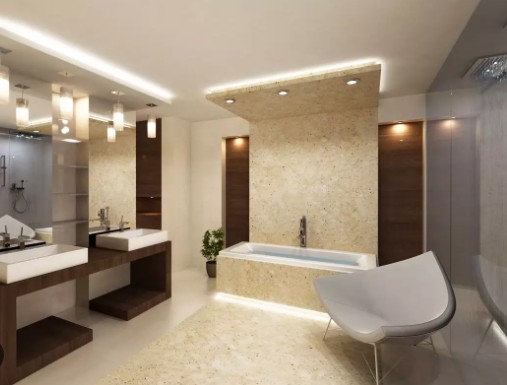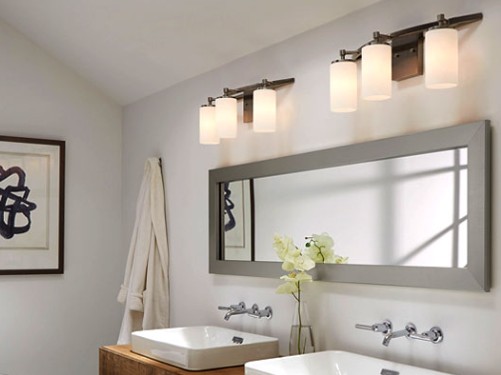When it comes to safety at home, bathroom lights are nowhere near the top of the list of the things we worry would hurt us. However, the truth is these lights can be a safety hazard during an electric shock, so you may want to know, do bathroom lights need to be GFCI protected?
The National Electrical Code does not explicitly require bathroom lights to be GFCI protected. However, while not protecting your bathroom lights is not illegal, that doesn’t mean you shouldn’t do it. GFCI protection on your bathroom lights will help protect you if an electric shock occurs.
Bathroom lights may not be mandated to have protection, but let’s tackle what GFCI is and its benefits in your bathroom.

Do Bathroom Lights Need to Be GFCI Protected? (GFCI Defined)
Ground Fault Circuit Interruption (GFCI) is a safety device that cushions against electric shock hazards in damp areas. It monitors the flow of electric current in a bathroom circuit and turns off the power if imbalances occur between power suppliers and return conductors.
The GFCI constantly tracks the electric current flowing through the circuit, comparing one on a hot wire to one on a neutral wire. After detecting an error around the lights, it sends a code that activates a tripping mechanism.
Consequently, the GFCI cuts off power within a fraction of a second to prevent electric shocks and potential injuries. It is an important safety feature in bathrooms, kitchens, and other areas with high risks of electrical accidents.
Without GFCI protection in your bathroom, you could suffer electrocution when you touch water or a faulty electrical outlet. In connection with that, experts recommend regular GFCI testing to ensure proper functioning, a prerequisite for adequate protection.
Do All Bathroom Outlets Need GFCI?
According to the National Electric Code (NEC) and safety standards, all outlets in your bathroom should have GFCI protection. It includes electrical outlets near water sources like the sink and bathtub.
The regulation aims to enhance electrical safety by reducing the risk of electrical shocks in damp environments. The GFCI helps detect ground faults quickly and interrupts the electrical circuit before an accident occurs.
Even though electrical codes mandate you install at least one GFCI, you can fix two or three to enhance protection. It is up to you to ensure you have one in the restroom and near water inlets.
However, there are exceptions to this rule. Outlets installed outside wet areas or away from water sources may not need GFCI protection.
For instance, switches installed on walls away from the shower or sink don’t need protection. Other examples include recessed lights and waterproof light fixtures.
Therefore, it is imperative to consult with a certified electrician or refer to the electrical codes in your region to determine the correct GFCI requirements for your bathroom outlets. The two will provide reliable information based on your locality’s regulations.
When Do Your Bathroom Lights Need GFCI Protection?
NEC demands the inclusion of GFCI protection under the following circumstances:
1. Bathroom Lights Installed Above The Shower Area
When positioning bathroom lights above the shower area, consider the condensation that commonly forms in that area. It can cause electric fire and shock if the light fixtures cannot endure damp conditions.
Condensation introduces moisture into your bathroom’s electrical components, compromising the integrity of the lights. What follows are electrical malfunctions and short circuits.
Local electrical codes require GFCI protection for lights installed close to the shower. The purpose is to detect ground faults and electrical imbalances when water splashes onto the power components.
If you have fluorescent, incandescent, or other non-waterproof light fixtures, it is not mandatory to add GFCI protection. Nonetheless, installing the protection boils down to your preference.
If you decide not to use the safety device for non-waterproof fixtures, assess the potential risks involved. Although they have no direct contact with water, accidental splashes or condensation can cause significant damage.
Therefore, integrating a ground fault circuit interrupter provides extra protection for non-waterproof electric fixtures, ensuring a safe environment for your household.
2. Non-recessed Bathroom Lights
When bathroom lights are not recessed, the need for ground-floor circuit interrupter protection rests on their proximity to water sources. Generally, the GFCI comes in handy to protect them from condensation, steam, or splashes.
Recessed lights in a bathroom boast a sleek and streamlined experience. Their design shields them from excessive exposure to moisture, unlike their non-recessed counterparts.
Reduced exposure to moisture in recessed lights mitigates water infiltration and damage to non-waterproof fixtures. However, exercise caution when installing lights near water sources.
3. Light Fixtures Without Wet/Damp Rating
In the present world, most modern bathroom light fixtures feature a wet rating. The attributes guarantee suitability for use in wet conditions.
Manufacturers designed damp-rated lights to withstand condensation prevalent in bathrooms and saunas, excluding the shower area. On the other hand, wet-rated bathroom lights suit environments in continuous contact with water.
According to the NEC, bathroom lights with a wet rating don’t require GFCI protection. You can fix the ground fault circuit interrupter when the fixtures lack wet ratings.
What Shows Your Bathroom Lights Have GFCI Protection?
These steps will help you figure out if the bathroom lights have GFCI protection:
1. Check The Circuit Breaker
Locate the circuit breaker panel in your home, usually a small black box, and identify the circuit that controls the bathroom lights. If it features a GFCI breaker, it will show that the lights are GFCI protected.
2. Examine The Electrical Outlets
The next thing to do is inspect the electrical outlets in your restroom. GFCI outlets have distinct characteristics that set them apart from regular outlets.
Look for outlets with power “Test” buttons and switch them on. Connect a light fixture like a lamp and try to turn it on to check its lighting.
If your lamp switches on, it signifies your bathroom lights lack GFCI protection. Otherwise, pressing the “Test” button should cut off the power.
If your lamp turns green, it shows your light fixtures have GFCI protection.

3. Consult A Certified Electrician
After ensuring your lights lack GFCI protection, it is expedient to seek professional help. Hire a qualified electrician to examine the bathroom’s electrical wiring and determine whether to install the safety device for lights only.
The professional will incorporate a circuit interrupter in your bathroom to safeguard your lights from electrical malfunctions. On top of that, the expert will install the device in line with the National Electric Code.
What Are The Advantages Of Installing GFCI In Your Bathroom?
Fixing a GFCI in your bathroom comes with benefits that include:
1. Protecting Your Appliances
The GFCI prevents electrical damage to your bathroom appliances. It does so by monitoring electric current and detecting ground faults and imbalances.
In the event of an electric leak or other abnormalities, the safety device interrupts the circuit, cutting off the power supply in a fraction of a second. This prompt response shields your appliances from unsteady electrical current, which could compromise their internal components.
Consequently, GFCI protection prolongs the lifespan of your bathroom appliances.
2. Prevents Electrocution
A bathroom is an inherently wet environment, making it more susceptible to electrical hazards. The presence of sinks, showers, and other water fixtures increases the likelihood of accidental contact between water and electrical devices.
Installing a ground fault circuit interrupter minimizes the risk of electric shock, which arises after accidentally touching electric appliances. Water and electricity are “sworn” enemies, and touching power outlets with wet hands is hazardous.
One advantage the GFCI offers is the ability to detect imbalances occasioned by water coming into contact with bathroom electrical components. What follows is a swift response to cut off the power supply, which alleviates the electric shock.
3. Minimizes Electric Fire Hazards
Faulty electrical appliances can be fire hazards, thus posing a significant risk to your bathroom and your safety. Non-GFCI and non-waterproof fixtures are the main culprits behind the fires.
If a ground fault stems from wiring issues or appliance malfunctions, the GFCI shuts off the power. This response mitigates overheating and the possible ignition of nearby flammable materials.
By interrupting the circuit, the safety device keeps your bathroom safe, protecting your appliances and home from fire hazards.
Can Bathroom GFCI And Lights Share A Circuit?
You can have the bathroom’s GFCI and lights share a circuit. However, this requires the electrical circuit to serve the bathroom only and not any other area.
NEC recommends installing the GFCI and lights on different circuits. The reason is that the safety device is essential for outlets in areas near water sources.
The electrical code suggests installing the two on separate circuits so that if a ground fault occurs in an electrical outlet, it won’t interfere with the lighting circuit. The reverse is also true.

Where Should You Fix GFCI Outlet In Your Bathroom?
GFCI protection is necessary for bathroom areas where electrical outlets, electrical switches, and light fixtures are susceptible to moisture exposure. Experts recommend having the safety device within the bathtub, sink, countertop, or shower stall for reliable protection.
While installing a single-circuit interrupter suffices, you will find homeowners opting for two or three GFCI outlets. This way, they feel more secure from electrical malfunctions.
Moreover, extend the ground fault circuit interrupter beyond the bathroom to other damp areas, such as the kitchen and laundry room.
Can You Install GFCI Bathroom Light Yourself?
You can install a GFCI protection device if you have the required expertise. But if you are unsure, consider hiring a qualified electrician to fix the circuit interrupter correctly to ensure your safety as well as that of your appliances.
Handling electrical systems can be hazardous if not done correctly. Besides, an electrician will fix the safety device correctly, following electrical codes and regulations.
Should You GFCI Protect Shower Lights Yourself?
Generally, electrical fixtures in the bathroom, such as shower lights, need GFCI protection. This is because the area around the shower is moisture-laden, which can cause electrocution.
However, damp-rated and wet-rated shower lights can do without the circuit interrupter.
Final Remarks on Do Bathroom Lights Need To Be GFCI Protected?
In conclusion, GFCI protection is a requirement for bathroom lights since they are in a moisture-prone area. The safety device prevents electrical shocks and other accidents in damp areas.
While the specific requirement may vary based on local electrical regulations, professionals advise installing GFCIs for bathroom lights near wet areas.
Also, read:
